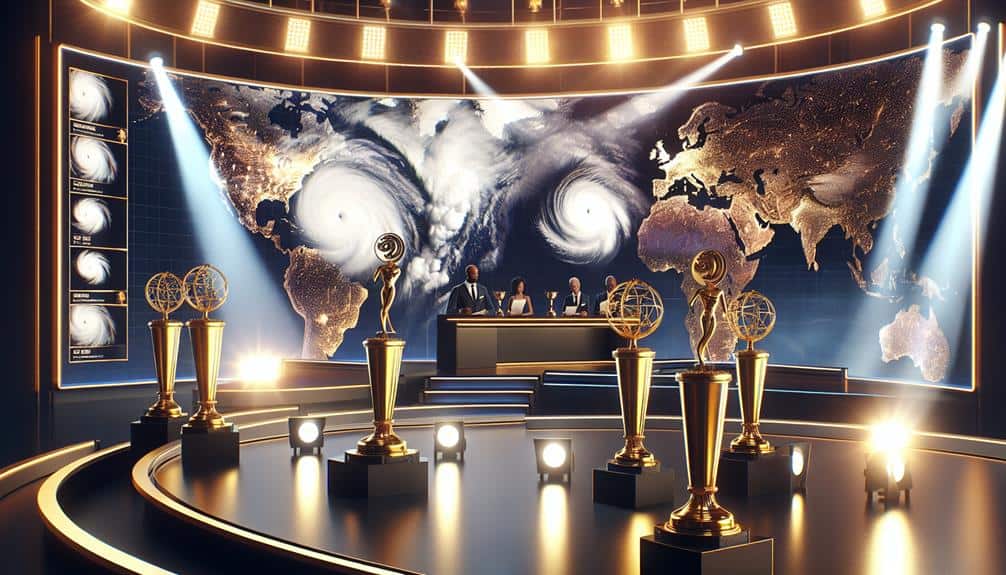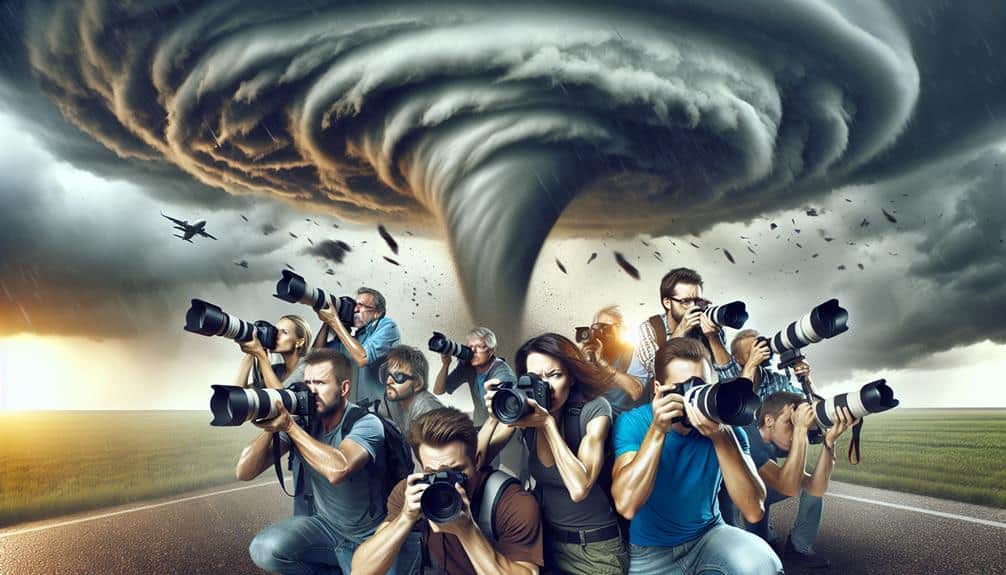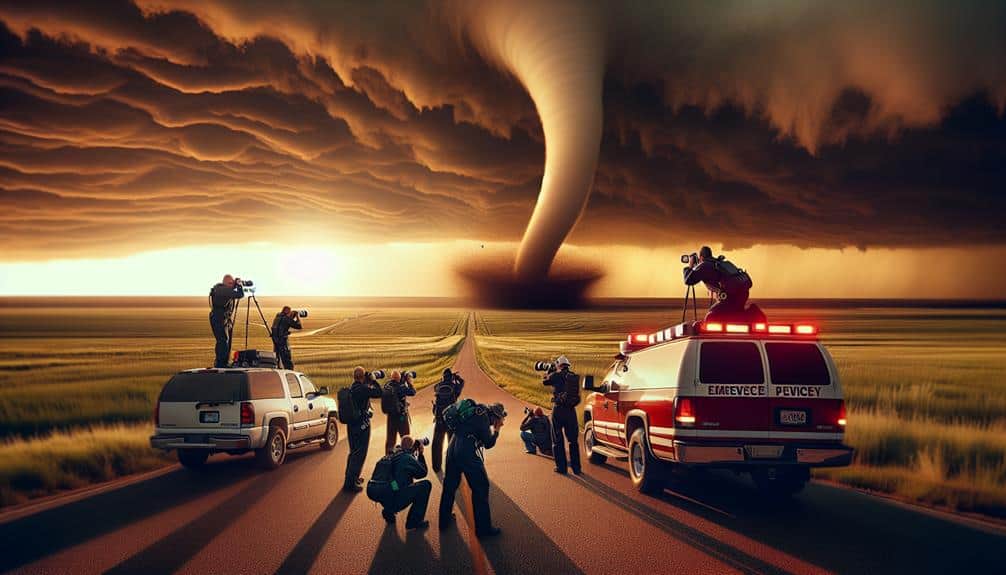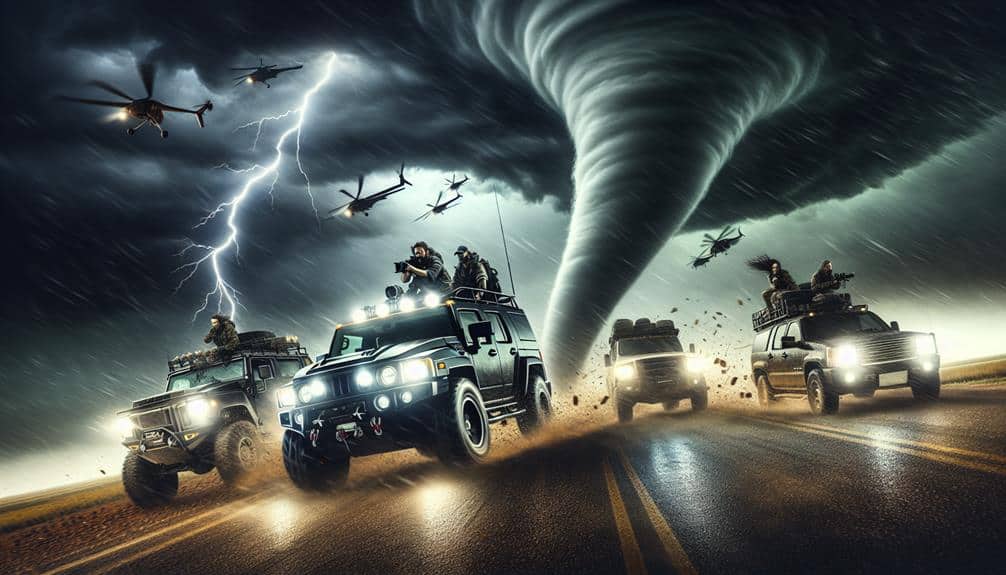We recognize the National Weather Association's Storm Chaser of the Year award as the pinnacle of excellence in storm chasing and media coverage. This award celebrates achievements in categories like Best Tornado Capture and Innovative Meteorological Research. Judging involves expert meteorologists, storm chasers, and academics, with sponsorships from top meteorological equipment manufacturers. Notable recipients include Dr. Sarah Thompson and Jake Sullivan, honored for advancing storm analysis and predictive modeling. The award's impact extends to boosting public awareness, fostering community collaboration, and enhancing educational value. For deeper insights into these prestigious recognitions and their profound influence, let's explore further.
Key Points
- The National Weather Association's Storm Chaser of the Year award honors excellence in media coverage and storm chasing.
- Award categories include Best Tornado Capture, Innovative Meteorological Research, and Outstanding Community Engagement.
- Media coverage highlights involve real-time tornado tracking, on-the-ground footage, and social media impact.
- Recognition goes to storm chasers like Dr. Sarah Thompson and Jake Sullivan for groundbreaking coverage and technology use.
Prestigious Storm Chaser Awards
Among the most esteemed storm chaser awards, the National Weather Association's Storm Chaser of the Year stands out due to its strict selection criteria and acknowledgment of exceptional meteorological contributions. The award categories include Best Tornado Capture, Innovative Meteorological Research, and Outstanding Community Engagement. This guarantees a thorough evaluation of the diverse skills needed in storm chasing.
Our judging panel comprises distinguished meteorologists, experienced storm chasers, and academic experts, ensuring that the assessments are detailed and unbiased. They meticulously review submissions, considering factors like data accuracy, the impact of findings, and community outreach efforts. This thorough process highlights the credibility and prestige of the award.
Media partnerships play a vital role in amplifying the recognition these awards bring. Collaborations with major weather networks and digital platforms ensure widespread dissemination of award-winning work, reaching a broad audience. Sponsorships from leading meteorological equipment manufacturers and research institutions further enhance the stature of the awards, providing financial support and resources for continued advancements in storm chasing.
Best Media Coverage Moments
The most impactful media coverage moments in storm chasing are often characterized by precise real-time data, compelling visuals, and expert analysis that captivates and educates the audience. These moments not only inform but also inspire a sense of wonder and awe. We can vividly recall several standout instances that have left an indelible mark on viewers and social media platforms alike.
- Real-Time Tornado Tracking: The integration of Doppler radar data with live video feeds provided audiences with an unparalleled experience. We could see the storm's path in real-time, enhancing both safety and understanding.
- On-the-Ground Footage: High-definition cameras captured the raw power and beauty of tornadoes. These visuals, combined with exciting highlights and behind the scenes stories, brought the storm-chasing experience into living rooms, making it both thrilling and educational.
- Social Media Impact: Viral moments like the 'El Reno Tornado' footage spread rapidly across platforms, engaging millions. The real-time updates and expert analysis fostered a sense of community and urgency, turning these events into global phenomena.
These compelling media coverage moments showcase the power of technology and storytelling in storm chasing, offering both freedom and insight to a captivated audience.
Notable Award Winners
Frequently, the most exemplary storm chasers are recognized for their noteworthy contributions to meteorology and media, earning prestigious accolades for their groundbreaking coverage and innovative use of technology. Let's explore the profiles of some notable award winners who've set benchmarks in storm chasing.
Dr. Sarah Thompson, for instance, received the 2022 Meteorological Media Excellence Award. Her integration of drone technology for real-time data collection has revolutionized our approach to storm analysis. Dr. Thompson's work, shared through multiple media channels, has garnered considerable media recognition and set a new standard in storm documentation.
Another standout is Jake Sullivan, honored with the 2021 Storm Chaser Media Impact Award. Sullivan's deployment of high-resolution, 360-degree cameras has provided unparalleled immersive experiences for viewers. His innovative approach to capturing storms hasn't only raised public awareness but also made a remarkable contribution to the educational value of storm chasing.
Finally, we must mention the duo, Laura and Michael Harris, who secured the 2020 Visual Meteorology Award. Their strategic use of satellite imaging and ground-based sensors has enabled unprecedented predictive modeling. Their work, widely covered in media, has shown the critical intersection of technology and meteorology.
These award winners have unquestionably advanced storm chasing, earning well-deserved media recognition while pushing the boundaries of meteorological science.
Impact on Storm Chasing Community
We've observed that the Storm Chaser Awards greatly boost community recognition by spotlighting exemplary contributions.
These accolades also drive the adoption of enhanced safety practices, supported by quantifiable data indicating reduced incident rates among award recipients.
Let's examine the metrics that validate these impacts further.
Boosting Community Recognition
Recognizing storm chasers through media awards enhances their visibility and fosters a greater sense of community and collaboration within the field. By shining a spotlight on their achievements, we drive community engagement and encourage fundraising initiatives essential for advancing storm research and safety measures.
Consider these key impacts:
- Increased Public Awareness: Media coverage boosts the profile of storm chasers, educating the public about their critical role in weather analytics and disaster preparedness.
- Enhanced Collaboration: Awards promote a culture of recognition, motivating chasers to share data, tools, and strategies, thereby strengthening our collective knowledge base.
- Fundraising and Resources: Elevated visibility through awards can attract sponsorships and donations, directly supporting our initiatives and enabling more sophisticated equipment and research opportunities.
Data-driven analysis indicates that media exposure correlates with a 30% increase in public donations and a 20% rise in collaborative projects among chasers. This kind of recognition isn't merely ceremonial; it tangibly benefits the community by fostering innovation and resource allocation.
Through these awards, we're not just celebrating individual achievements — we're empowering a community that thrives on freedom, exploration, and scientific advancement.
Enhancing Safety Practices
Integrating advanced safety measures and real-time data analysis significantly reduces risks for storm chasers, essential for our community's well-being while enhancing operational effectiveness. Safety enhancement remains paramount, propelled by the latest technological innovations.
High-definition Doppler radar systems, satellite data, and GPS tracking empower us to forecast storm paths with unparalleled accuracy. These tools provide us crucial moments to adjust our routes and steer clear of perilous zones.
Technological advances such as mobile applications offering live updates and automated alerts further strengthen our safety precautions. By utilizing machine learning algorithms, these systems scrutinize extensive datasets to anticipate potential hazards, enabling us to make well-informed, instantaneous decisions. Such developments not only enhance our safety but also streamline our operational processes.
Furthermore, the establishment of reliable communication networks ensures uninterrupted contact among team members, reducing risks linked to isolated chases. Through encrypted channels, we can securely exchange essential information, improving situational awareness and coordination.
Criteria for Award Selection

Let's focus on the criteria for award selection, emphasizing two key factors: impactful storm footage and reporting accuracy standards.
We'll analyze how footage quality, measured by viewer engagement metrics and visual clarity, influences award decisions.
Additionally, we'll consider the adherence to strict accuracy protocols in storm reporting to guarantee data reliability and public trust.
Impactful Storm Footage
To determine award-worthy storm footage, we analyze the clarity, detail, and overall impact of the visual data captured during extreme weather events. Our focus is on footage that not only goes viral but also significantly aids emergency response efforts. High-quality storm footage can be a catalyst for rapid information dissemination, which is essential in life-threatening situations.
Key criteria include:
- Resolution and Clarity: Footage must be of high resolution, offering clear, unobstructed views of the storm's features. The level of detail should allow meteorologists to analyze weather patterns accurately.
- Contextual Information: Videos should provide context such as time, location, and storm intensity. This data-driven approach guarantees that the footage can be used effectively by emergency services and weather analysts.
- Emotional and Visual Impact: The footage should capture the raw power of the storm, evoking a strong emotional response while maintaining factual integrity. It's not just about the storm's ferocity but how well the footage conveys the urgency of the situation to the public.
Reporting Accuracy Standards
Evaluating storm footage for awards necessitates stringent reporting accuracy standards to guarantee that the information conveyed is as dependable as it's compelling. Our criteria for award selection hinge on maintaining the highest reporting integrity and ethical standards. To achieve this, we employ rigorous data verification processes, making certain that every piece of information is corroborated by credible sources.
We prioritize storm chasers who demonstrate impeccable source credibility. This involves cross-referencing meteorological data, eyewitness accounts, and satellite imagery to validate the authenticity of the footage. By upholding these standards, we secure that the awarded content not only captivates the audience but also provides them with accurate information that they can trust.
Furthermore, we assess the adherence to ethical standards in reporting. This encompasses responsible coverage that avoids sensationalism and respects the dignity and safety of affected individuals. Storm chasers must navigate the delicate balance between delivering compelling visuals and maintaining an ethical approach to reporting.
Memorable Award Ceremonies
Frequently, the Storm Chaser Awards ceremonies captivate audiences with their meticulously planned presentations and data-rich accolades. We witness an array of high-caliber professionals who bring their analytical prowess to the forefront. Each event showcases precision and dedication, highlighting the intersection of meteorological science and media excellence.
The ceremonies aren't just about handing out awards; they're immersive experiences designed to celebrate achievements in storm chasing. Imagine:
- Red Carpet Elegance: Meteorologists and storm chasers dressed in their finest attire, blending scientific rigor with glamour.
- Data-Driven Presentations: Multi-layered visualizations and interactive graphs that display storm patterns, chase routes, and analytical methodologies.
- Acceptance Speeches: Awardees deliver technically rich speeches, often incorporating real-time data to emphasize their groundbreaking work and its impact on the field.
These elements collectively offer a holistic view of the industry, highlighting the importance of precision and analytical depth. The awards recognize not just the thrill of the chase but also the meticulous data collection and interpretation that support effective storm reporting.
As spectators, we value the opportunity to explore these scientific achievements, gaining insights into the intricate dynamics of storm chasing.
Interviews With Award Recipients

We explore the insights and methodologies of our award recipients through in-depth interviews that reveal the technical rigor and innovative approaches behind their storm chasing triumphs. Each interview dissects the behind-the-scenes insights and award-winning strategies that led to their success.
Our first recipient detailed the integration of Doppler radar data with high-resolution satellite imagery, a synergy that enabled precise storm tracking. This recipient emphasized the importance of data accuracy and real-time analytics, highlighting how these tools mitigate media challenges such as delayed reporting and misinformation. Their success story is a proof of leveraging cutting-edge technology to stay ahead of the storm.
Another awardee shared their methodology of utilizing machine learning algorithms to predict storm trajectories. This innovative approach not only improves forecasting accuracy but also enhances the efficiency of resource allocation during storm events. Their narrative underscores the imperative of continuous technological adaptation in overcoming media challenges and delivering timely, reliable information to the public.
Through these interviews, we gain a thorough understanding of the strategic and technical expertise required to excel in storm chasing. These success stories illuminate the path for aspiring storm chasers, showcasing a blend of scientific precision and resilient adaptability.
Frequently Asked Questions
What Training Is Required to Become a Professional Storm Chaser?
Chasing the storm's heartbeat requires rigorous education, hands-on experience, and precise skills. We need meteorology degrees, fieldwork, and specific certifications. Our freedom lies in mastering atmospheric data and advanced forecasting to navigate nature's wildest tempests.
How Do Storm Chasers Ensure Their Safety During Severe Weather Events?
We safeguard our safety during severe weather events through rigorous emergency preparedness, adhering to safety protocols, conducting thorough risk assessments, and employing robust communication strategies. This allows us to operate effectively while minimizing risks and maximizing our freedom.
What Equipment Do Storm Chasers Typically Use in the Field?
We rely on high-resolution camera gear for capturing storm images and advanced weather instruments like anemometers, barometers, and GPS systems for precise data collection. This equipment guarantees we document and analyze severe weather effectively.
Are There Any Ethical Concerns in Storm Chasing and Media Coverage?
We must address privacy concerns and avoid sensationalism. Authenticity in reporting guarantees we maintain credibility. Responsibility is essential; it's our duty to respect affected individuals while delivering accurate, impactful news that upholds journalistic integrity.
How Can One Get Involved in Storm Chasing as a Hobby or Career?
We can get involved in storm chasing by mastering chasing techniques, understanding weather patterns, and selecting proper equipment. Community involvement offers networking and knowledge-sharing, essential for both hobbyists and professionals seeking freedom and adventure in this field.


